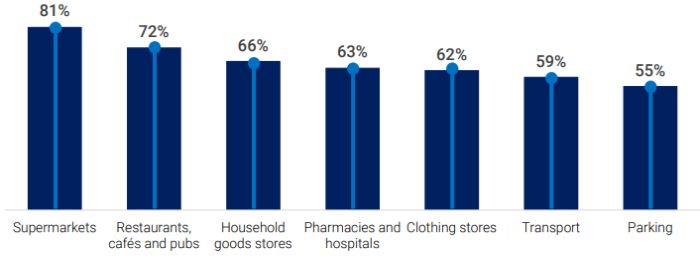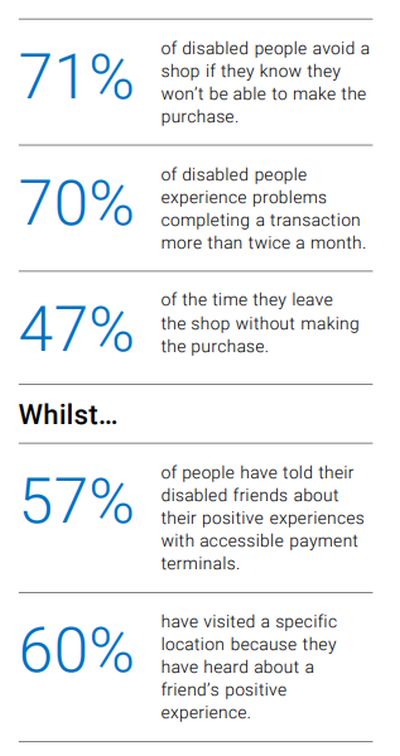Introduction
There have been huge advances in technologies to automate in-person payments and checkout experiences in recent years – think contactless, self-checkout, multi-function touchscreens, mobile wallets, and pay-by-app for parking.
But the advances that make life easier for many often do little to help disabled people, and in some cases can make life harder.
The business cases for these advances seem clear in speeding up checkouts, reducing queues, and reducing the number of staff in stores to assist customers. However, we wanted to understand the commercial opportunity for merchants and their payment providers in investing in solutions that help disabled people make easier payments at retail and hospitality outlets.
Around 25% of people in the U.K. have some kind of disability that impacts their day-to-day life, and approximately six million households in the U.K. have at least one person with a disability1. Making payments more accessible to disabled people ought, therefore, to make good business sense.
To find out, AlixPartners worked with Project Nemo, the fintech disability inclusion campaign, to survey 350 disabled people and carers. We also ran an in-depth focus group to understand why payments can be difficult for disabled people, what strategies they use to cope, what they do when they can't complete a payment, and how businesses and payment providers can do more to win and retain this group's custom.
We identified a revenue opportunity of around £70bn-a-year in high street retail and hospitality – primarily from attracting and retaining the custom of disabled people and their families.
70% of the people we surveyed said they actively avoided shopping at locations where they knew they would have a problem completing a payment. In addition, around two-thirds of people said in the previous month they had actively chosen a location because they knew it had accessible payment terminals.
This is also a community that shares information; almost 60% of people had told their disabled friends about a positive experience with accessible payments, and 60% also said they have been influenced to visit a specific location after hearing about a friend's positive experience.
We estimate the impact of these positive referrals and experiences at £32bn annually across the U.K.
However, there is also an opportunity – potentially worth £38bn a year – from salvaging negative experiences, as disabled people often are forced to leave a location without making the purchase they wanted to.
Breaking down the barriers to completing a payment
Key areas of opportunity
"I feel totally disempowered from making payments."
Payment terminals are a crucial part of the shopping experience, but they can present significant challenges for disabled customers. Based on extensive feedback from this customer group, including analysis of hundreds of free-text responses within our survey, we found three main areas where merchants and their payment providers could improve the payment experience:
- A more accessible environment around the checkout and payment terminal
- Improvements to payment terminals themselves
- More – and better – staff assistance
A more accessible environment around the checkout and payment terminal
Physical layout barriers are one of the most significant causes of frustration for disabled users. 57% of the responses referenced the need for terminals or card readers to be more physically accessible.
Many individuals, particularly wheelchair users, reported difficulty reaching terminals. One customer suggested: "Bring the terminal closer if possible or help my card get onto the terminal." Another said merchants could help by "making sure tills are wide enough for my wheelchair and lowering the card reader to me, as well as helping me pack or taking stuff to my car."
The physical environment around terminals often lacks sufficient space for manoeuvring, making it difficult for those using mobility aids. Customers wanted merchants to ensure paths to terminals are clear and easily navigable, card readers are within easy reach, and payments desks are accessible for wheelchair users.
"Have lower tills so I don't have to shout to be heard and can reach the items and card reader."
Improvements to payment terminals themselves
For many, payment terminals are not just physically inaccessible – they are also difficult to use. Customers with visual impairments cited issues with small, low-contrast text and poorly positioned screens.
"It's really frustrating when the text on payment screens is too small for me to read," commented one. High-contrast, larger screens, and clearer writing on screens were common requests.
Auditory challenges were also prevalent. Deaf or hard-ofhearing customers often missed audio prompts. Some customers also requested sign language support or textbased communication tools, such as telecommunication relay services.
"The queues are always tough for me as it takes me time to pay - there are always other customers waiting behind me."
Another recurring concern voiced by disabled customers was feeling rushed or overwhelmed at payment terminals, for example because on-screen prompts move too quickly, or because of social pressures when there are queues forming.
Many disabled customers prefer to maintain their independence while making payments. They appreciate it when staff are available to help, but do not want to rely on them entirely, instead preferring to use payment terminals independently. One customer expressed: "I'd rather not have to rely on them (staff) at all – nobody else has to."
Ensuring that payment terminals are easy to use allows disabled customers to complete transactions independently.
More – and better – staff assistance
The quality and availability of staff support has a significant impact on experiences for disabled customers. Feedback from our survey and focus group revealed that staff often lack awareness of the specific needs of disabled customers. One visually impaired customer shared: "I'll be standing right in front of the cashier, and they'll say, 'you can pay here'... but I can't see." Other customers complained of similar experiences.
Some indicated that feeling rushed during transactions is a significant issue, and that staff sometimes display signs of frustration or impatience with how long it takes them to complete a payment and leave the payment area. One customer said: "On staffed checkouts, it's about having patience and not immediately making a frustrated observation about someone as soon as they've moved away because they took too long, or making them feel like they shouldn't be out on their own if they can't do things quickly."
Another customer said staff should be prepared to allow extra time and maintain a calm and helpful tone throughout the transaction. Some customers went as far as to say that a lack of patience from some staff had made them feel unwelcome or burdensome. Some suggested that staff should be trained in sign language or use written instructions when needed.
Disabled customers struggled when payment amounts were not read out, steps were explained too quickly, or visual and written aids were not provided. For those with hearing impairments, the absence of lip-reading, sign language, or written instructions made transactions particularly challenging. Additionally, customers felt frustrated when staff made assumptions instead of asking how they could assist, leading to a sense of being misunderstood and unsupported.
A recurring theme was the importance of respecting the autonomy of disabled customers. While help is appreciated, it should be offered respectfully and only when needed. Some customers preferred to be left to complete their transaction independently, while others wanted staff to follow their lead rather than take over. Maintaining dignity and avoiding patronising behaviour is key.
Overall, a common belief among those we spoke to and surveyed was that one size does not fit all.
"I am a rock climber, but anything to do with payments is more stressful than rockclimbing - riskier as well."
The challenges identified in our research can have significant emotional and practical impacts. Disabled customers face extended times to access and use payment terminals, which can greatly affect their experience. One disabled customer explained: "I try and avoid places with these [terminals], especially where shops have removed the majority of staffed tills. As a disabled person, I have to queue for far longer than an able-bodied person, and this is uncomfortable."
In particular, a number of respondents said the issues they encounter can affect their independence and leave them more reliant on others. "I have to go home and get one of my kids or my wife to look at my receipts to make sure of my payments," said one.
Another added: "I have to rely on other people to spend my own money." These experiences underscore the significant challenges faced by individuals when systems are not designed with accessibility in mind.
The business opportunity
In the previous 30 days, how many times did you (or the person you care for) choose to visit a location because you were aware that it had accessible payment terminals?


As you can see above and opposite, data from our survey presents an extremely compelling business opportunity.
We also heard numerous stories from our focus group that reinforced the survey findings, whether it was customers using local, independent shops rather than big grocery stores because they knew someone would help them, or specifically going somewhere because the parking payment terminal had large, easy-to-read-and-use screens.
One focus group member said they now visit a neighbouring town 10-15 miles away because the parking payment machines are designed with accessibility in mind. They said: "It is my new place to go and park because I can pay easily and with my phone. It makes my life easier."
Another customer highlighted their preference for a specific shopping centre where staff cater to their needs. "The staff have their card machines ready and hold them up for you," they said. "It's about the customer service." Another participant echoed this sentiment, adding: "The staff tell you everything in their communication – the amount, how much I paid, the change."
So, what can retailers, pubs and cafés do to capture this opportunity? Expanding on the three problem areas identified from our research, these solutions emerged repeatedly:
- Improved physical accessibility around the payment terminal
- Improvements to the payment terminals
- More, better-trained staff
To view the full pdf, click here.
Footnote
1. U.K. Parliament disability statistics – October 2024 (U.K. disability statistics: Prevalence and life experiences – House of Commons Library)
The content of this article is intended to provide a general guide to the subject matter. Specialist advice should be sought about your specific circumstances.


